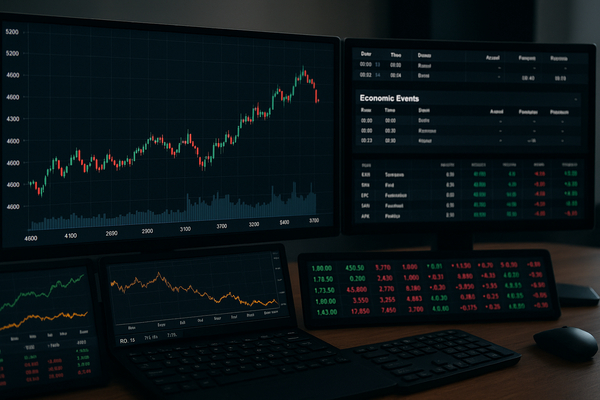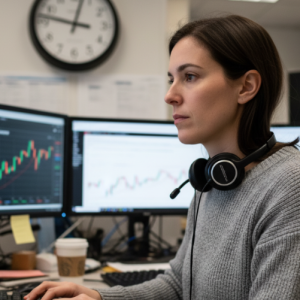
Global equity markets cooled slightly on Tuesday after an electrifying start to the week driven by renewed enthusiasm for artificial intelligence. The previous session sent Wall Street and global indices to fresh highs, but the coming trading day looks set to be shaped more by policy voices and fixed income supply than by company-specific headlines.
Investor focus has shifted because domestic politics in the United States have constrained the release of some economic data, putting Fed speakers in the spotlight. With Washington grappling with a shutdown, market participants will be parsing remarks from new Fed board member and former White House adviser Stephen Miran, along with other central bank figures. The outcome of those appearances could determine whether the pervasive risk-on mood extends or pauses.
The underlying momentum remains unmistakable. The MSCI all-country index climbed to a point nearly 19 percent above its level at the start of the year before Tuesday’s retreat. A fresh wave of dealmaking and AI-related optimism supplied much of the fuel. The semiconductor sector led the charge after a blockbuster supply pact in which OpenAI can buy AI chips from a major chipmaker and take up to a 10 percent stake. The news sent the chipmaker’s shares up about 24 percent and lifted the Philadelphia Semiconductor Index by almost 3 percent.
Corporate transactions outside technology reinforced the market’s appetite for risk. A regional bank agreed to be acquired in an all-stock transaction valued at about 10.9 billion dollars, sending the target bank’s shares sharply higher. Separately, an announced U.S. government stake in a mining company as part of an Alaska development push effectively doubled its U.S. listed shares overnight. Those moves underline a broader willingness among investors to price in stronger corporate activity and strategic bets on assets exposed to artificial intelligence and resources.
Macro crosscurrents are creating distinct differences between equities and bonds. The dollar strengthened against the euro and the yen as political developments abroad altered monetary expectations. In France, the shock resignation of the prime minister weighed on local equities, bonds and the euro on Monday. The outgoing prime minister was granted two days of consultations to try to resolve the crisis, and domestic markets stabilised somewhat on Tuesday. Markets are weighing whether the French president might dissolve the National Assembly, but for now reactions have been relatively muted because global liquidity remains supportive.
Japan supplied another important piece of the global policy puzzle. The weekend victory by the new leader of the ruling party makes it likely the country will have its first woman prime minister and points to a more dovish fiscal stance. That outcome has pushed the yen down near levels last seen on August 1, with the currency close to 150.91 per dollar. Long dated Japanese government bond yields have been climbing, with a relatively smooth 30 year auction easing some concerns yet still leaving yields higher. Expectations for bigger fiscal outlays combined with a slower path to BOJ rate hikes are steepening Japan’s yield curve and keeping a lid on any rapid yen recovery.
Markets have also been sensitive to central bank posture more broadly. If the Federal Reserve resumes policy easing in earnest, as many now expect, the impact would be to keep U.S. financial conditions unusually loose. Consensus forecasts referenced in the commentary point to about 50 basis points of additional easing by year end, bringing the policy rate closer to 3.5 percent. The European Central Bank’s rates are already back near three year lows of around 2 percent. That constellation of policy settings helps explain why stocks and inflation hedges such as gold have been rising, while bond volatility sits near multi year lows.
Commodities have been responding to the same forces. Gold traded near a record close to 3,977 dollars an ounce as investors price the risk of easier real rates and persistent inflation pressures. Oil has held modest gains on steady messages from supply overseers. Digital assets gave back a portion of earlier gains as risk appetite redistributed across asset classes.
For the coming session there are a few market events that could act as catalysts. The Treasury will sell 58 billion dollars of three year notes, an offering that could test demand in a market where volatility has been low. The bid tone for that supply will matter for short dated yields and could influence stock market sentiment if the auction shows either stress or exceptional demand.
Several central bank officials are scheduled to speak, including the Fed’s Vice Chair for Supervision and regional bank presidents. Those remarks will be scrutinised for any nuance about the pace of easing and the Fed’s reaction function in the face of still elevated inflation. Attention will also be paid to the European Central Bank president who is set to speak, even as domestic French political developments are watched closely for any escalation that might pressure regional assets.
On the data front, U.S. consumer credit for August is slated for release and a Canadian trade balance print is expected earlier in the day. With the government funding situation in Washington muddling some schedules, any surprises in released numbers could amplify market moves because investors will be eager for fresh signals about household resilience and cross border trade flows.
The current market configuration presents a set of clear tensions for traders and longer term allocators. Elevated equity valuations and booming deal activity rest on the assumption that policy will remain supportive. That assumption is reinforced by gold’s advance and unusually low Treasury volatility. The counterpoint comes from pockets of political risk in France and the prospect that fiscal splurges in Japan will keep local yields elevated even as global rates retrace lower. Should Fed speakers signal a faster easing timeline or should the Treasury auction show weak demand, volatility could rise quickly.
For the session ahead, expect price action to be determined by how policy voices are heard and how fixed income dealers absorb a large Treasury supply. Equities carry the momentum of a recent AI narrative and corporate deal flow, but their durability will be tested by evolving central bank commentary and the interplay between government politics and global liquidity. Traders who watch the sequence of Fed remarks and the three year auction will gain the clearest read on whether the market takes another step higher or pauses to reassess the balance between policy support and political uncertainty.
Markets are not short of storylines. Technology optimism, strategic corporate moves, the path of rate cuts, and political developments in major economies all sit within reach of a single trading day. That concentration of potential drivers means the coming session could feel small in directional surprise but large in informational significance.












